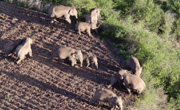Aussie study finds a deep-sea brittle star sole survivor of 180 million years of evolution
SYDNEY, June 24 (Xinhua) -- It has taken years of painstaking genetic research but marine scientists from the Australian state of Victoria have finally confirmed that a ferocious-looking brittle star with eight spindly arms equipped with eight jaws of razor-sharp teeth, is the last known direct descendant of a species dating back to when dinosaurs first roamed the Earth.
The alien-looking sea creature, known officially as Ophijura, was collected during a trawl of the ocean floor off the coast of New Caledonia in the southwest Pacific Ocean in 2011. But it has taken a decade to unravel its peculiar DNA.
The researchers, led by Museums Victoria marine senior curator Dr. Tim O'Hara, have published their findings in the latest edition of the journal Proceedings of the Royal Society B.
O'Hara said the team compared DNA from a range of species, and concluded Ophijura was "separated from its nearest living brittle star relatives by about 180 million years of evolution".
"A microscopic scan revealed bristling rows of sharp teeth lining every jaw, which I reckon are used to snare and shred its prey," he wrote.
The abundance of arms (most brittle stars, which are related to starfish, have five arms) and the myriad teeth are not the only distinctive features, as an electron microscope revealed the skeleton contained thousands of pairs of holes which look, in O'Hara's words, like "pig snout articulations".
During the research, O'Hara sent part of the specimen to a colleague in the European country of Luxembourg, who after several months realized the snout-like openings resembled fossils from the Jurassic period.
Following the brittle star discovery, O'Hara told Xinhua he was keen to head back into unexplored marine territory. Next month he will lead a 45-day voyage of Australia's oceanic research vessel, the RV Investigator, to underwater mountains, called seamounts, around Christmas Island and Cocos Islands off the coast of Western Australia.
"These seamounts are up to 100 million years old. That's the dinosaur era, and almost totally unexplored," O'Hara said. "We are truly excited at what we may find."
[ Editor: WPY ]










More From Guangming Online
Medics from Fujian leave for Shanghai to aid in battle against COVID-19 resurgence
New int'l land-sea transport service to Indo-China Peninsula launched
Another makeshift hospital under construction in Shanghai
Tourists view tulips in Suiping County, Henan
In pics: blooming gagea flowers on grassland in Zhaosu, Xinjiang
Greek workers stage 24-hour general strike over high prices